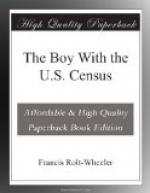“I had never realized the need of all that preparatory work,” the boy admitted.
“There’s a great deal of the work that has to be done in the years before the census and in the years after,” he was informed, “and the Bureau is kept just as busy as it can be, all the while. The Decennial Census, although it is the biggest part of the census work, is only one of its many branches, and then there are always other matters being looked after, like the Quinquennial Census of Manufactures, and such numberings as those of the Religious Bodies and the Marriage and Divorce Statistics of a few years ago.”
“I understood the Bureau had regular work all the year round?” Hamilton said.
“Indeed it has. All the births and deaths that are registered are tabulated here, and a number of tables of vital statistics are worked out which are of immense value to doctors not only in the United States but all over the world. Then, as I think you know, we have for years made a special study of cotton crop conditions, and there is a bulletin published at stated intervals showing the state of the cotton industry in the United States. Then there is all the statistical work on cities of over 30,000 inhabitants, and there is scarcely a question which has reference to the population or the manufacturing interests of the country that is not referred sooner or later to the Bureau of the Census.”
“You work with the Forest Service, too, I believe,” said Hamilton. “Wilbur Loyle, a forest ranger whom I knew very well, showed me some figures that the Bureau had prepared.”
“Only in the collection and publication of statistics of forest products,” said Barnes, rising and changing his office coat,—for the conversation had run on long after office hours,—“owing to their co-operation the task is not cumbersome; questions of information or special statistics asked for by Congress or by the executive departments take up a great deal of time when added to an already extensive routine work.”
Editing the schedules of the population of Alaska, just as Hamilton had expected, proved to be of the most intense interest, since, despite the closest desire on the part of the enumerators to confine themselves strictly to official facts, the wildness of the frontier life would creep in. An example of this was the listing of an Eskimo girl on the schedule as having “Sun” and “Sea” for her parents with an explanatory note to the effect that she had been found as a tiny girl upon a heap of sea moss on the beach. Another was when an enumerator wrote on his schedule under ‘language spoken,’ “Some pesky lingo; I know most of their talk, but this was too much for me and the hut was too strong to stay in long.”
Such comments made it easy to create a picture of the semi-savagery of the fur-clad fishers on the shores of the Arctic Sea.
Another schedule, one which interested the boy greatly, was that in which the age of an Indian was described as “200 snows.” To try to get this worked out to the probably true age of 80 or 90 years evidently had been quite a task. The enumerator wrote:




